20 Years of Sharing Presentation Insights—and What’s Next for 2026
20 Years!
This is a momentous blog post. I started sharing presentation-related content online in 2006 – that was 20 years ago!

I started here with ThePowerPointBlog.com, then added Facebook and later LinkedIn posts. Over the years, the voice of TLC Creative Services has grown beyond just me to include our incredibly talented presentation design team, who added to many of the posts.
In 2025, we took a big step forward by bringing on a dedicated social media manager. Her role has been to keep our posting consistent, and core themes each month. One of my favorite initiatives this past year, which was suggested by our social media manager, was our “Looking Back” series. Each Friday, we revisited a past blog post that was still relevant to PowerPoint and presentation design today. There is a lot of information and knowledge here, and the “Looking Back” series included posts originally shared 18 years ago! This series was shared on both The PowerPoint Blog and our TLC Creative LinkedIn account. It was a fun way to reflect on how far presentation design has come, and how far we’ve come with it.
What’s Ahead for 2026?
We’re excited about what’s next! Here’s a quick look at what we’re cueing up for 2026:
- For the blog: We’ll share two new posts every week (Tuesday & Thursday)
- For our Presentation Podcast: We’ll continue dropping two episodes each month (on the first & third Tuesdays)
- TLC Creative Facebook & LinkedIn: Posts aligned with blog content, plus more behind-the-scenes photos and updates.
- VXP Meetings LinkedIn: This is a new channel for 2026 where we are (finally) sharing information focused on our virtual meeting tools and production; specifically, tutorials, case-studies, and real-world projects
The Goal?
My goal is the same: sharing resources, tutorials, example files, and conversations about presentations. We are happy to have TLC Creative Services, Inc. as part of everyone’s presentation journey in 2026. Whether you’re looking for inspiration, practical tips, or just want to see what’s possible in the world of presentation design.
Thank you for joining us at TLC Creative, as we are all part of the presentation community. Here’s to a creative and connected 2026!

-Troy @ TLC
It’s New Year’s Eve – Happy New Year 2026!
As each year is a trip around the sun, Jake from the TLC Creative presentation design team created a PowerPoint animation celebrating New Years around the world!

Want to make your own PowerPoint animations? Check out some of our posts on creating animations within PowerPoint!
The TLC Creative team wishes you a Happy New Year!
FREE PowerPoint Template – A Bright Future Ahead
Feel free to download and use this beautiful full function PowerPoint template entitled “A Bright Future Ahead” – which feels appropriate as we get ready for 2026 to begin in a few days!
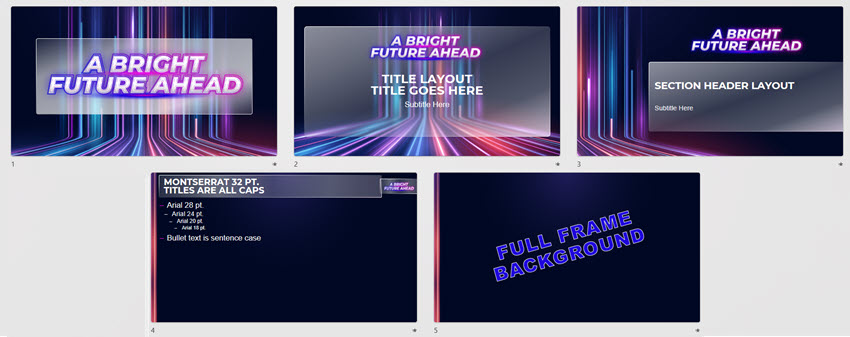
Download here (1.9 MB, .pptx file)
-The TLC Creative Team
A Look Back at Using PowerPoint’s Picture Fill for Dynamic Slide Design
Two years ago, we wrote a blog post about one of PowerPoint’s most underutilized features: the PICTURE FILL option.
This option, with creative use, can take a presentation slide from good to GREAT! So, let’s revisit how to take stock vector art (such as .svg) and make it dynamic using PowerPoint’s Picture Fill.
First, is adding a nice Christmas tree .svg graphic that is appropriately themed for this time of year.
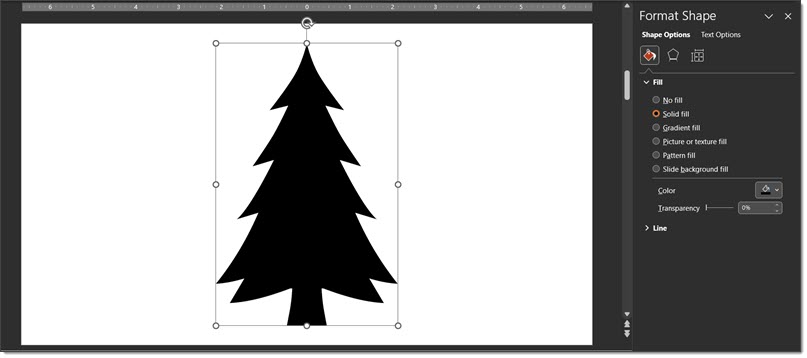
COLOR FILL
Obviously, we can use the paint bucket to change the color of the tree, but a step further is to use PowerPoint’s gradient fill option.
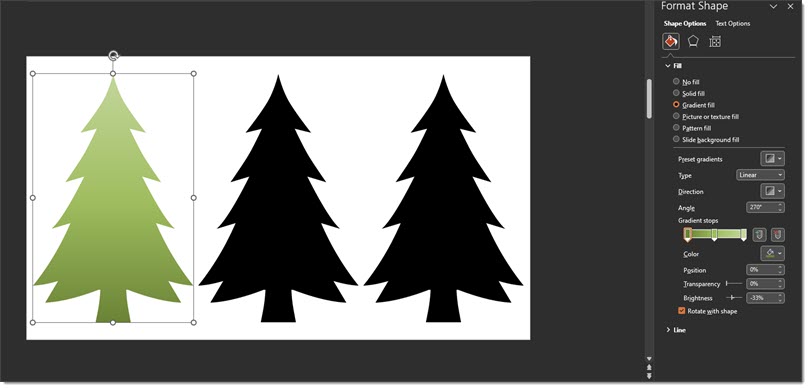
A gradient fill (left tree image) is a bit more stylized than solid green (middle tree image).
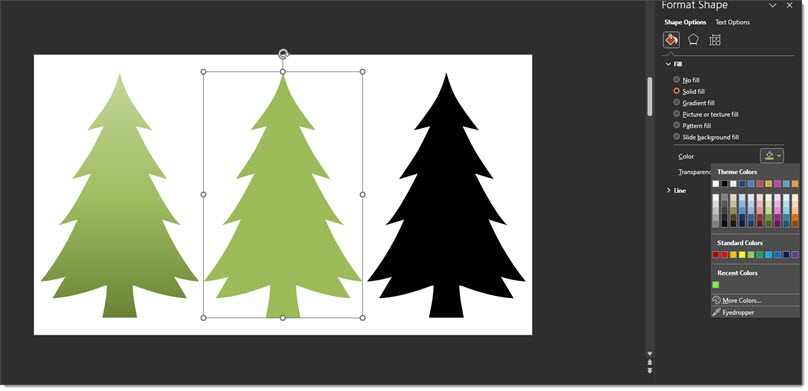
But maybe hold off using the pattern fill options for this example (right tree).
Just as a note: if you’re doing a pattern fill, the pattern colors and the background color can both be customized – but still, let’s hold off on using the pattern fill for this slide!
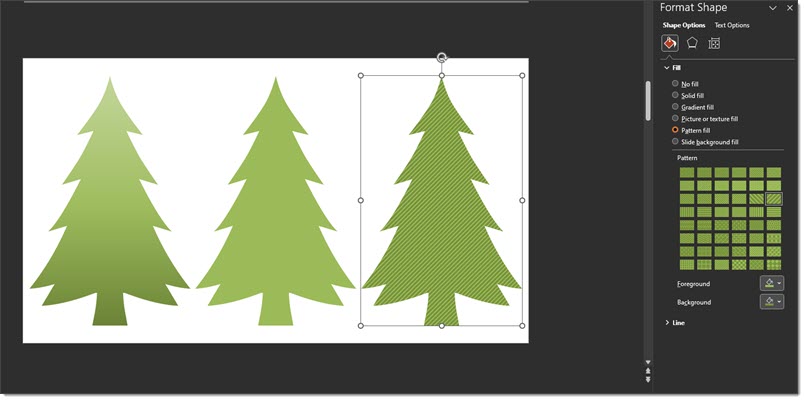
PICTURE FILL
And while these are all nice options, we can get an even more realistic result if we use the Picture Fill option! To use this option, select your vector art on the slide > open the FORMAT SHAPE dialog > then select PICTURE OR TEXTURE FILL > then locate the photo image you want to use within your computer.
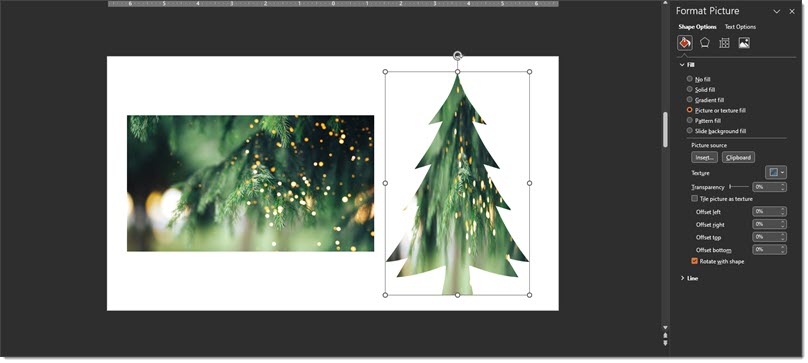
Here’s a tip! If you don’t want to go through the above rigamarole, you can also CTRL + C the photo image you’d like to use, and then simply click on your vector image and paste the photo into your vector art!
You’ll also notice that the inserted image is distorted to fit into the size of the vector art (the tree). You can adjust the distortion and size by using PowerPoint’s CROP tool.
First, select the tree > click the CROP tool > adjust the width of the fill image with its size/shape points. This, of course, applies to vector art of any shape or size!
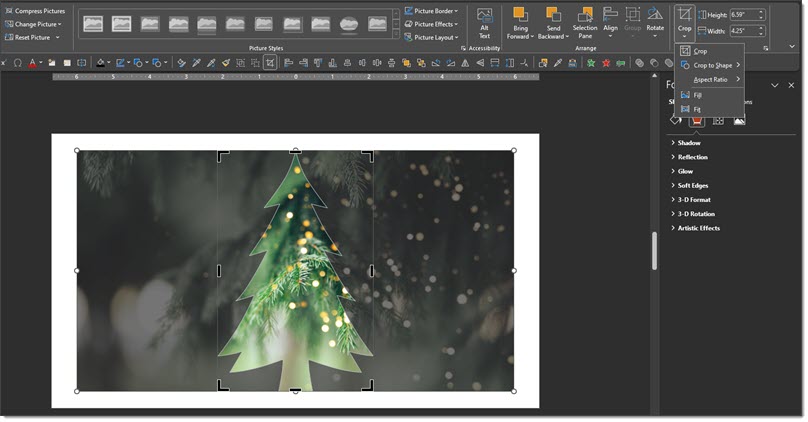
And here is the final slide from our December 21, 2023 blog post – polished vector art and all design created directly in PowerPoint. Download this slide to use in your own presentations here!

-Troy @ TLC (with special thanks to Christie for this design example, created 2 years ago!)
The TLC Creative 2025 Christmas Card
We love Christmastime at TLC Creative Services! Over the years, we’ve created some fun holiday cards, sometimes turning our creativity into games and activities, and other times making some fun interpretations of the world around us.
Last year, we asked AI to decorate our office for the holidays. This year, we asked AI to write a poem for us for our annual Christmas card. The results? Well, see for yourself…

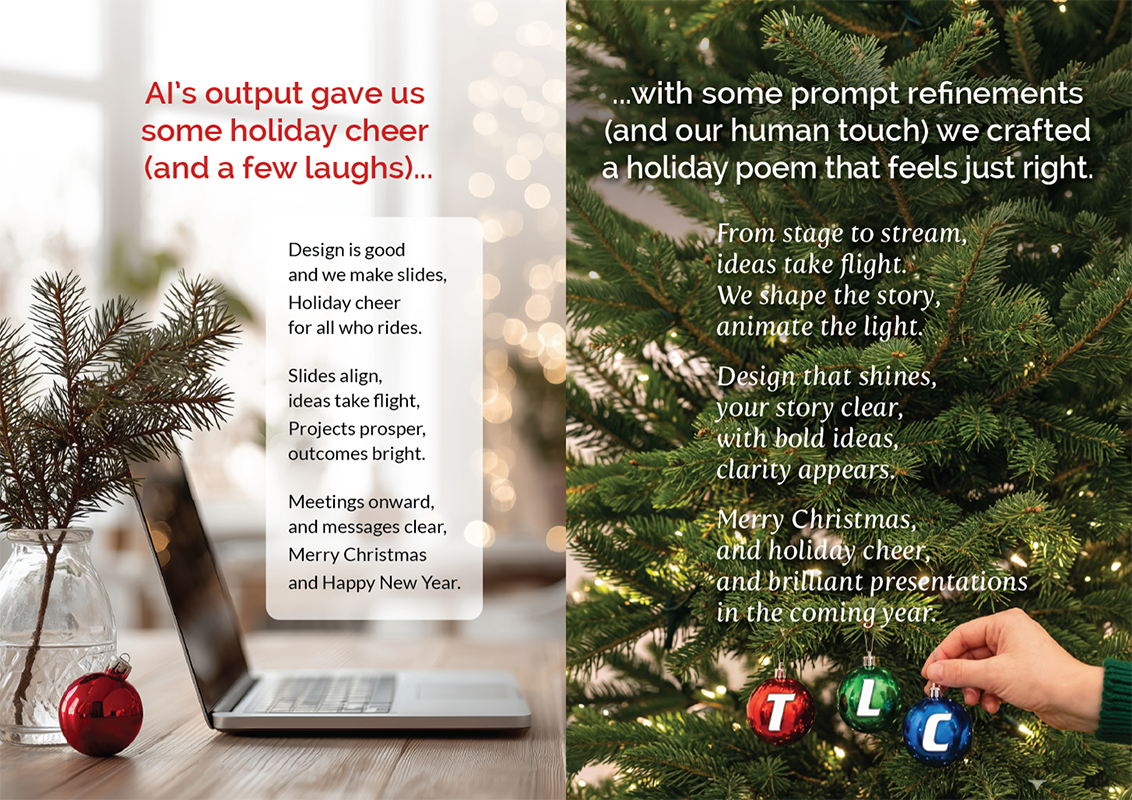
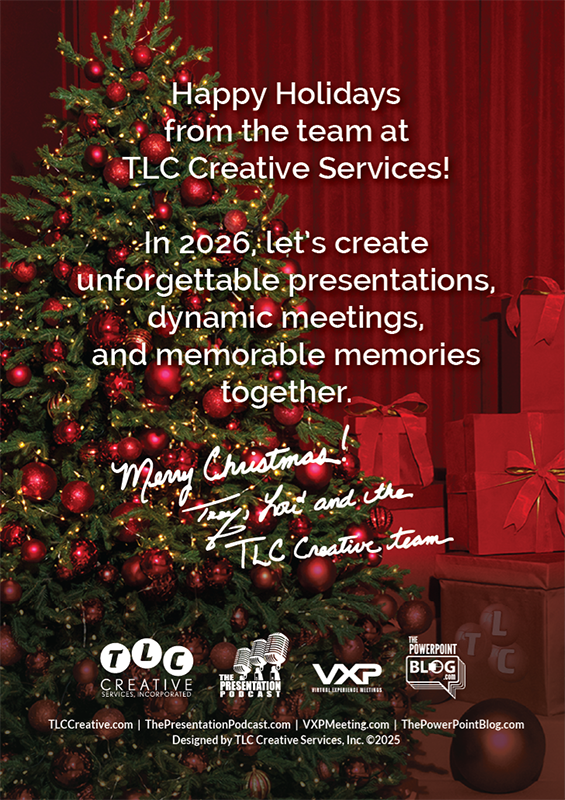
We wish you a very happy holiday season!
– Lori, Troy, and the TLC Creative team
Add a “Traffic Light” Timer to Speaker Notes Slides!
Speaker Notes have been part of PowerPoint for a loooong time. As a result, we’ve experienced many of the formatting, display, and export limitations that Speaker Notes has – usually during one of the many corporate event projects we handle.
However, limitations aside, Speaker Notes are definitely something in our standard workflow! Whether they be from a teleprompt system, using PowerPoint’s Presenter View, or separate “Notes Slides” (which is what we are going to talk about today), Speaker Notes are a must-use for us.
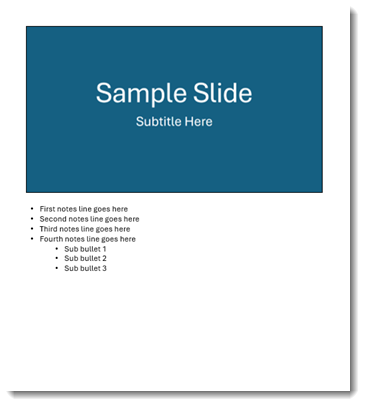
Notes Slides
Lately, we have been asked more often to develop and manage “Notes Slides”. First, let’s describe and define what “Notes Slides” are, as they are a hack to presenting with PowerPoint (the same can be done with Keynote or Google Slides). These are slides that have notes for a presenter to reference, but are not shown to the audience
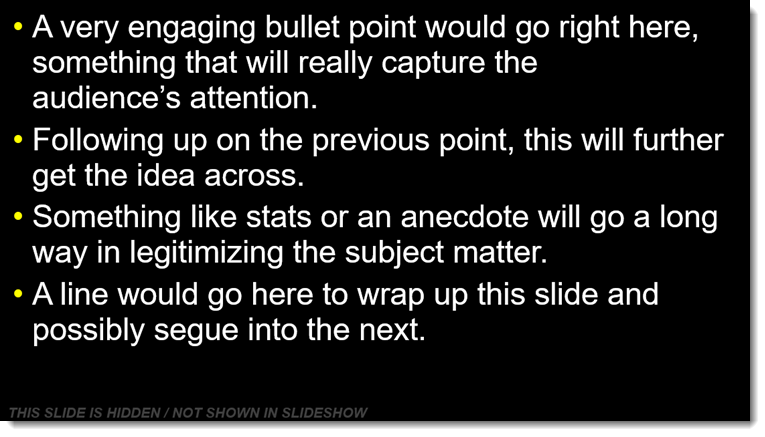
The idea is simple: for every presentation slide, create a parallel slide that has the presenter notes. We are not using a teleprompt system (though always our preference for stage presentations!), and we are not using Presenter View.
For example, on the left is the presentation of 10 slides. On the right is a matched set of 10 “Notes” slides, one notes slide for each presentation slide (and click-for-click aligned to any animations that may be used on the presentation slides, but that’s for another day).

This example is based on a live event with at least 2 confidence monitors, viewable by the presenter from the stage. One confidence monitor shows the slide the audience sees on the screens, and the other confidence monitor shows the “Notes Slide” associated with that audience slide.
Presentation Pace and Timing
Another ask from presenters is to add timestamp notes or other indicators so they can target their pace for specific slides or pace their overall presentation. This is something we can easily do with Notes Slides (hint to Microsoft: this would be another good widget to add to Presenter View!).

Traffic Light and Traffic Bar

A novel and visual solution is to add an animated “traffic light” to each Notes Slides. The idea is that when the traffic light is green, the presenter is on pace and has time for the slide. When it is yellow, the presenter knows they need to wrap up that slide’s content. And when it shows red, it is time for the presenter to go to the next slide.
Here is one way the TLC Creative design team implements a “traffic light bar” in Notes Slides. We basically add a thin, animated PowerPoint rectangle with a gradient from green to yellow to red, positioned either along the top of the slide, the bottom of the slide, or vertically top-to-bottom on the side.
![]()
When used in a slideshow, it works just like a stoplight going from green to yellow to red. When animated with the “Wipe” animation, each bar is preset to finish animating at the allotted time for each slide. So, as you click on the Notes Slide, you see green – which means you are on track! When yellow appears, it is a reminder to wrap up. Red signals that it is time to move on to the next slide.
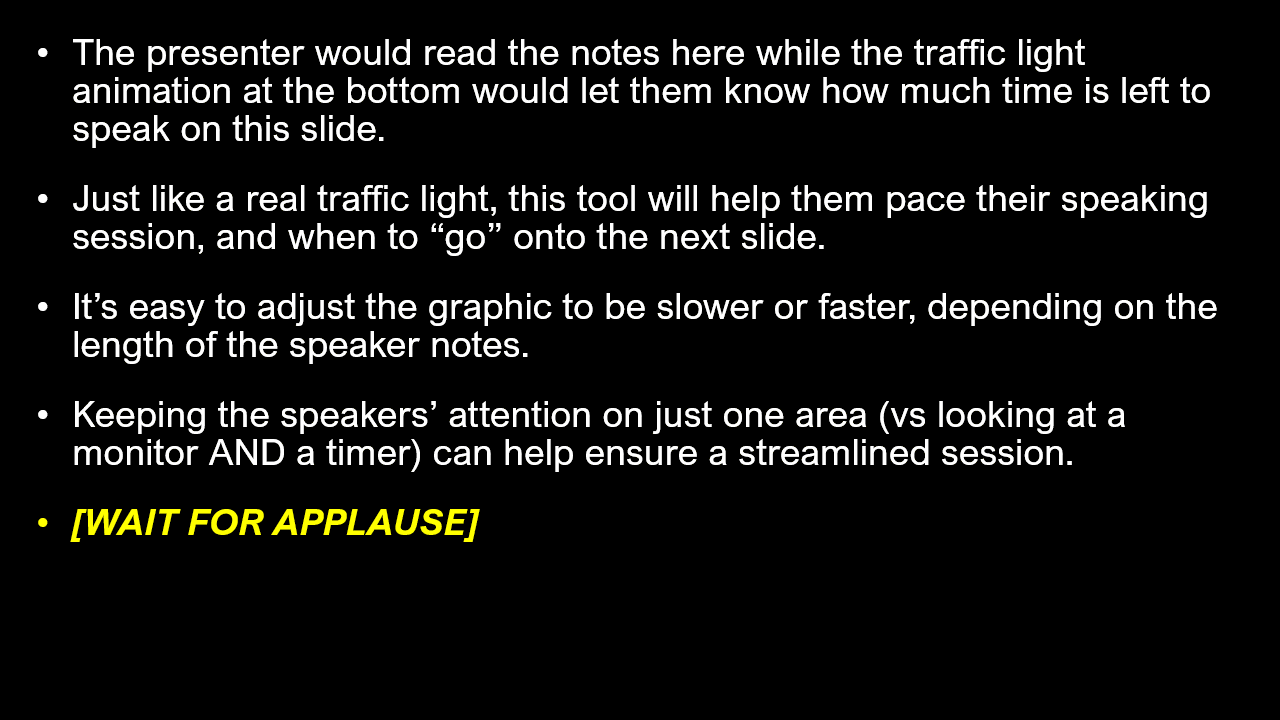
One key benefit is that the traffic light bar timing can be adjusted for each slide. The above example is a 10-second timer: green for the first 7 seconds; yellow from 8-9 seconds; red for the last half-second.
The goal is to make this visual simple and intuitive for presenters to monitor their pacing on each slide – the animating colors are easier to visually process than looking at an actual timer.
The result is less stress on stage, smoother timing, and audiences get the full story without the show running long. This is a small production trick that makes a big difference in live events and is quickly becoming a favorite among the executive teams we work with.
Create Your Own Traffic Light Bar
Creating a “traffic light” bar is simple:
- Add a thin PowerPoint rectangle
- Size it to fit across the top or bottom of the slide
- The goal is to be thin so it does not interfere with the notes, but is clearly visible as well
- Fill the thin rectangle with a gradient
- Right-click the shape
- Select Format Shape
- Go to Shape Options
- Go to Fill
- Select Gradient Fill
- Add gradient stops for the green, yellow, and red sections, keeping the yellow section at the 80-95% area and the red at the very end.
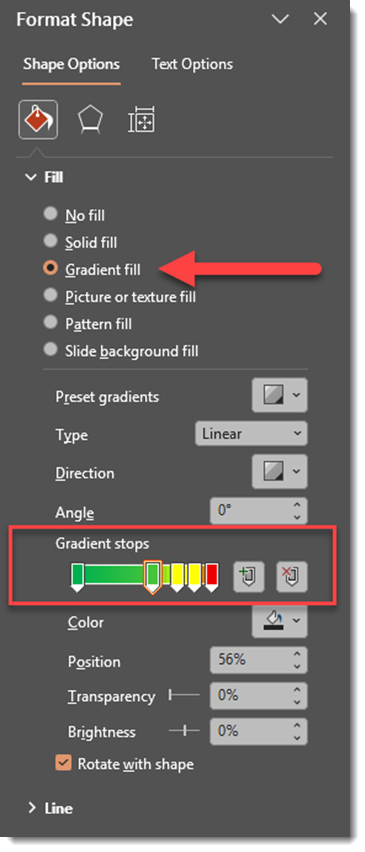
Animate the Traffic Light Bar
- With the shape selected
- Go to the Animations tab
- Choose Wipe, and in the Effect Options, set to Direction from the From Left

- Set the animation to start With Previous
- Update the animation duration to match the determined speaking time for that slide. For our example further above, the wipe animation duration is 10 seconds.

TIP: Adjust the yellow and red gradient stop positions to adjust when each traffic light color displays.
Happy Presenting
With Notes Slides and a traffic light bar working together, presenters know what to say and exactly how long they have to say it. The setup is quick and easy, and the payoff is a presentation that flows smoothly, stays on time, and delivers a stronger experience for the audience.
-Jake & the TLC Creative design team
A Look Back to Amazing PowerPoint Animations in this Holiday-Themed Post from 2017!
It wouldn’t be the holidays at the TLC Creative studio without holiday themed PowerPoint animations from the design team!
As part of our Look Back series, where we revisit blog posts from the past, this Friday we are looking back at our fun Christmas animation collection from from 2017 – eight years ago! Everyone on the team made their own animation, and then we compiled the slides and exported them as a video. Enjoy – again!
Happy Holidays from all of us at TLC Creative Services!
